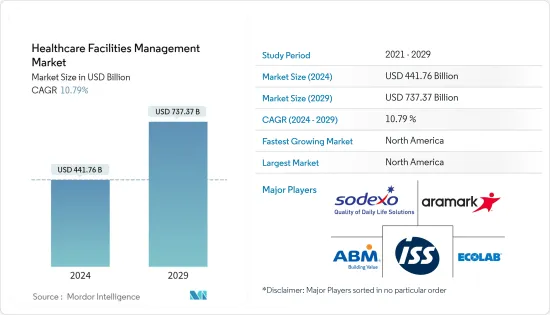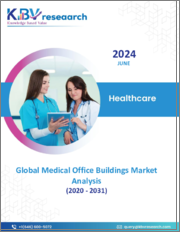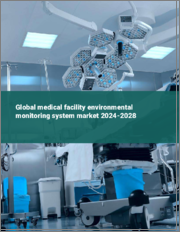
|
시장보고서
상품코드
1432986
헬스케어 시설 관리 : 시장 점유율 분석, 산업 동향 및 통계, 성장 예측(2024-2029년)Healthcare Facilities Management - Market Share Analysis, Industry Trends & Statistics, Growth Forecasts (2024 - 2029) |
||||||
헬스케어 시설 관리 시장 규모는 2024년 4,417억 6,000만 달러로 추정되며, 2029년까지 7,373억 7,000만 달러에 달할 것으로 예상되며, 예측 기간(2024-2029년) 동안 10.79%의 CAGR로 성장할 것으로 예상됩니다.

COVID-19 팬데믹으로 인해 전 세계 의료 시설 시장의 성장이 광범위하게 확대되었으며, COVID-19 환자 수가 증가함에 따라 COVID-19 진단 및 치료 건수도 증가하여 엄청난 양의 의료 폐기물이 발생했습니다. 2022년 2월 세계보건기구(WHO)가 발표한 데이터에 따르면, COVID-19 대응 과정에서 발생한 대량의 추가 의료 폐기물이 전 세계 의료 폐기물 관리 시스템에 큰 부담을 주고 있습니다. 또한, 팬데믹 이후에도 지속가능한 의료 시설 관리 시스템을 유지하기 위해 시장의 요구가 증가할 것으로 예상되며, 이는 향후 5년 동안 조사 대상 시장의 성장을 촉진할 것으로 예상됩니다.
헬스케어 시설 관리 시장은 전 세계 의료비 증가와 신흥국의 만성질환 및 의료관광 증가로 인해 급속한 성장이 예상됩니다.
환자 수 증가와 의료 시스템에서 민관 관계자들의 의료비 지출 증가로 인해 의료는 주요 부문 중 하나가 되었습니다. 2021년 7월에 발표된 OECD 보건 통계에 따르면, 16개 국가 그룹에 대한 의료비 지출 잠정 추정치에 따르면 1인당 의료비 지출이 평균 약 4.9% 증가할 것으로 예상했습니다. 또한 미국 메디케어 메디케이드 서비스 센터(CMS)가 발표한 데이터에 따르면 미국의 국민 의료비 지출은 2018년부터 2027년까지 연평균 5.5%씩 증가하여 6조 달러에 육박할 것으로 예상됩니다. 2018년부터 2027년까지 의료비 지출은 GDP보다 높은 연간 0.8%의 성장률을 기록할 것으로 예측됩니다. 그 결과, GDP에서 헬스케어가 차지하는 비중은 2027년까지 19.4%에 달할 것으로 예상됩니다. 이에 따라 의료비의 비정상적인 증가로 인해 환자의 건강을 위해 다양한 병원 및 클리닉 시설의 개발이 이루어지고 있습니다. 이 요인은 시장 성장을 촉진할 것으로 예상됩니다.
또한, 만성질환의 증가도 시장 성장에 기여할 것으로 예상됩니다. 예를 들어, 유럽 암 정보 시스템이 2020년에 발표한 데이터에 따르면, 비흑색종 피부암의 예상 발생률은 2040년까지 324만 4,076명에 달할 것으로 예상됩니다. 암 발병으로 인한 부담은 많은 사람들이 장기 입원을 하게 될 것으로 예상됩니다. 이는 케이터링, 포터 서비스, 청소 및 기타 관련 서비스에 대한 수요를 증가시켜 시장 성장에 기여할 것입니다.
따라서 앞서 언급한 요인들은 예측 기간 동안 헬스케어 시설 관리 시장의 성장을 촉진할 것으로 예상됩니다. 그러나 공급자와 지불자 간의 격차와 저소득 국가의 시설 관리에 대한 투자 부족은 시장 성장을 억제하고 있습니다.
헬스케어 시설 관리 시장 동향
시장 성장이 기대되는 폐기물 관리
의료시설에서는 매일 상당한 양의 유해 및 비유해 폐기물이 발생합니다. 이러한 폐기물은 인간과 동물의 질병을 진단하고 치료하는 과정에서 발생합니다. 이러한 유해 폐기물은 부적절하게 관리하면 환자 치료의 질을 떨어뜨릴 수 있습니다. 이러한 폐기물은 환경 오염을 촉진하고 후천성면역결핍증후군(AIDS), 간염, 결핵, 디프테리아, 콜레라 등 감염성 질환을 확산시킬 수 있습니다.
2020년 2월에 발표된 유엔 자료에 따르면 2020년 3월부터 2021년 11월까지 약 8만 7,000톤의 개인보호구가 조달되어 유엔을 통해 운송되었습니다. 동시에 80억 회 이상의 백신이 투여되어 주사기, 바늘, 안전상자 형태로 14만 4,000톤의 폐기물이 추가로 발생했습니다. 이러한 고가의 의료 폐기물은 폐기물 관리 시스템에 대한 수요를 증가시켜 조사 대상 부문의 성장에 기여할 것으로 예상됩니다.
또한 2021년 중앙공해규제위원회(CPCB) 데이터에 따르면, 인도에서는 하루에 약 164톤의 신종 코로나 바이러스 관련 생물의료 폐기물이 발생하였다고 합니다. 이러한 의료 폐기물은 병원균과 독성 오염 물질을 환경에 방출하여 간접적으로 건강 위험을 초래할 수 있습니다. 따라서 의료 서비스 제공자들은 의료 폐기물을 효과적으로 관리하기 위한 프로그램을 수립하고 시행하기 위한 노력을 기울이고 있으며, 이는 해당 부문의 성장에 기여할 것으로 보입니다.
북미는 상당한 시장 점유율을 유지할 것으로 예상
북미 지역의 헬스케어 시설 관리는 견고한 헬스케어 인프라와 헬스케어 시설 관리를 위한 다양한 기술의 도입으로 인해 예측 기간 동안 건강한 성장을 보일 것으로 예상됩니다.
북미 지역의 의료 인프라의 전반적인 상황도 북미 지역과 크게 다릅니다. 또한 병원 수의 급격한 증가와 입원 환자 수의 증가로 인해 의료 시설 관리에 대한 수요가 증가하여 조사 대상 시장의 성장을 촉진합니다. 2022년에 발표된 미국병원협회(AHA)의 통계에 따르면 미국에서 활동하는 병원의 총 수는 약 6,093개에 달합니다. PRB 미국 고령화 조사에 따르면 65세 이상 미국인은 2060년까지 9,500만 명에 달할 것으로 예상됩니다. 지역 내 노인 인구의 증가와 만성 질환의 증가는 예측 기간 동안 의료 시설 관리 시장의 성장을 촉진하고 있습니다.
또한, 이 지역의 의료비 지출 증가는 시장 성장을 촉진할 것으로 예상됩니다. 예를 들어, CMS가 2021년에 발표한 보고서에 따르면, 2021년부터 2030년까지 국민 의료비와 GDP는 연평균 5.1% 성장할 것으로 예상됩니다. 높은 의료비는 예측 기간 동안 시장 성장에 기여할 것으로 예상됩니다.
또한, 만성 질환의 유병률 증가는 의료 시설 관리 시장의 수요에 기여할 것으로 예상되며, 이는 이 지역의 시장 성장에 기여할 것으로 예상됩니다. 미국 암 협회가 발표한 자료에 따르면, 2022년 미국에서 약 190만 명이 새로 암 진단을 받았다고 합니다. 이러한 만성 질환의 확산은 입원 환자 수의 증가로 이어져 궁극적으로 북미에서 더 나은 의료 시설에 대한 수요를 촉진할 것입니다. 이 지역의 시장 성장에 기여할 것입니다.
따라서 위의 요인들은 예측 기간 동안 조사 대상 시장의 성장을 촉진할 것으로 예상됩니다.
헬스케어 시설 관리 산업 개요
헬스케어 시설 관리 시장은 경쟁이 치열하며, 여러 주요 업체들로 구성되어 있습니다. ABM Industries Inc., Aramark Corporation, Ecolab Inc., Iss World Services A/S, Serco Group PLC, Sodexo 등이 이 시장의 주요 기업들입니다. 세계 헬스케어 시설 관리 시장에 참여하는 기업들은 최신 기술과 비용 효율적인 서비스를 제공하는 데 주력하고 있는 것으로 나타났습니다. 시장의 주요 기업들은 치료 효율성을 개선하고 시장 점유율을 높이기 위해 첨단 제품을 도입하여 시장 점유율을 높이기 위해 노력하고 있습니다.
기타 혜택
- 엑셀 형식의 시장 예측(ME) 시트
- 3개월간 애널리스트 지원
목차
제1장 서론
- 조사 가정과 시장 정의
- 조사 범위
제2장 조사 방법
제3장 주요 요약
제4장 시장 역학
- 시장 개요
- 시장 성장 촉진요인
- 헬스케어 지출 증가
- 만성질환 발생 증가
- 신흥국에서의 의료관광
- 시장 성장 억제요인
- 의료 제공자와 지불자 간의 격차
- 저소득 국가의 시설 관리 투자 부족
- 업계의 매력 - Porter's Five Forces 분석
- 신규 참여업체의 위협
- 구매자의 교섭력
- 공급 기업의 교섭력
- 대체품의 위협
- 경쟁 기업 간의 경쟁 강도
제5장 시장 세분화
- 제품 유형별
- 폐기물 관리
- 보안 서비스
- 케이터링 서비스
- 청소 서비스
- 기술 지원 서비스
- 기타 제품
- 최종사용자별
- 병원·클리닉
- 장기 헬스케어 시설
- 기타 최종사용자
- 지역별
- 북미
- 미국
- 캐나다
- 멕시코
- 유럽
- 독일
- 영국
- 프랑스
- 이탈리아
- 스페인
- 기타 유럽
- 아시아태평양
- 중국
- 일본
- 인도
- 호주
- 한국
- 기타 아시아태평양
- 중동 및 아프리카
- GCC
- 남아프리카공화국
- 기타 중동 및 아프리카
- 남미
- 브라질
- 아르헨티나
- 기타 남미
- 북미
제6장 경쟁 상황
- 기업 개요
- ABM Industries Inc.
- Aramark Corporation
- Ecolab Inc.
- Iss World Services A/S
- Jones Lang LaSalle
- Medxcel Facilities Management
- Ocs Group
- Serco Group PLC
- Sodexo
- Vanguard Resources Inc.
- Compass Group PLC
제7장 시장 기회와 향후 동향
KSM 24.03.07The Healthcare Facilities Management Market size is estimated at USD 441.76 billion in 2024, and is expected to reach USD 737.37 billion by 2029, growing at a CAGR of 10.79% during the forecast period (2024-2029).

The COVID-19 pandemic extensively widened the growth of the healthcare facilities market globally. With the rise in the number of COVID-19 patients, the increase in the number of diagnostics and treatments for COVID-19 was witnessed, resulting in the production of vast amounts of medical waste. According to the data published by WHO in February 2022, tonnes of extra medical waste from the response to the COVID-19 pandemic put tremendous strain on healthcare waste management systems worldwide. Moreover, to maintain sustainable healthcare facilities management systems even during the post-pandemic situation, the need for the market is expected to be on the rise, thereby boosting the growth of the studied market over the coming five years.
The healthcare facilities management market is predicted to witness rapid growth due to rising global healthcare expenditures, along with an increase in chronic diseases and medical tourism in emerging countries.
Healthcare has become one of the leading sectors, owing to the increasing number of patients and rising healthcare expenditure by the public and private players in healthcare systems. According to OECD Health Statistics released in July 2021, the preliminary healthcare spending estimates for a group of 16 countries suggested that per capita health expenditure increased by around 4.9% on average. Also, as per the data published by the Centers for Medicare and Medicaid Services (CMS), in the United States, national healthcare spending is projected to grow at an average rate of 5.5% per year during 2018-2027, reaching nearly USD 6.0 trillion by 2027. Healthcare spending is projected to grow 0.8% faster than the GDP per year over 2018-2027. As a result, the healthcare share of GDP is expected to rise to 19.4% by 2027. Thus, there has been exceptional growth in healthcare expenditures that have led to the development of various facilities in hospitals or clinics for the well-being of patients. This factor is expected to augment the market's growth.
Also, the increase in chronic diseases is expected to contribute to the market's growth. For instance, per the data published by the European Cancer Information system in 2020, the estimated incidence of non-melanoma skin cancer is expected to reach 3,244,076 by 2040. The burden of cancer cases is expected to be the admission of many people in hospitals for long-term care, thus boosting the demand for catering, porterage, cleaning, and other associated services, thereby contributing to the market's growth.
Thus, the aforementioned factors are expected to fuel the growth of the healthcare facilities management market over the forecast period. However, the gap between providers and payers and the lack of investment in facilities management in low-income countries are restraining the market's growth.
Healthcare Facility Management Market Trends
Waste Management Expected to Witness Growth in the Market
Healthcare establishments generate a considerable quantity of both hazardous and non-hazardous wastes daily. These wastes are caused due to the diagnosis and treatment of human and animal diseases. When inappropriately managed, these dangerous wastes may compromise patient care quality. These wastes may enhance environmental pollution and spread infectious diseases, including Acquired Immunodeficiency Syndrome (AIDS), hepatitis, tuberculosis, diphtheria, cholera, and many others.
As per the United Nations data published in February 2022, approximately 87,000 tonnes of personal protective equipment was procured between March 2020 and November 2021 and shipped through the UN. At the same time, over 8 billion vaccine doses have been administered, producing 144,000 tonnes of additional waste in the form of syringes, needles, and safety boxes. Such high medical wastage is expected to contribute to the demand for waste management systems, thereby contributing to the growth of the studied segment.
Additionally, according to the Central Pollution Control Board (CPCB) data in 2021, India generated nearly 164 tonnes of COVID-19-related bio-medical waste per day. These healthcare wastes may pose health risks indirectly by releasing pathogens and toxic pollutants into the environment. Thus, healthcare providers are on the verge of establishing and implementing programs to effectively manage healthcare waste, which is likely to contribute to the growth of the studied segment.
North America Expected to Hold a Significant Market Share
North America is anticipated to witness healthy growth in healthcare facilities management in the forecast period due to the robust healthcare infrastructure and the introduction of different technologies for healthcare facilities management.
The overall condition of the healthcare infrastructure also varies widely in the North American region. Also, the steep rise in the volume of hospitals and increasing hospital admissions drives higher demand for healthcare facilities management, thereby boosting the studied market growth. The American Hospital Association (AHA) statistics published in 2022 show that the total number of active hospitals in the United States is around 6,093. According to the PRB Aging in the United States, Americans aged 65 and older are projected to reach 95 million by 2060. The rising geriatric population and increasing chronic diseases across the region are augmenting the growth of the healthcare facilities management market in the forecast period.
Additionally, the rising healthcare expenditures in this region are expected to facilitate market growth. For instance, in the report published by CMS in 2021, on an average over 2021-30, National Health Expenditures and GDP are projected to grow 5.1% per year. High healthcare expenditures are expected to contribute to the market's growth over the forecast period.
Also, the increasing prevalence of chronic diseases is expected to contribute to the demand for the healthcare facilities management market, thereby contributing to the market growth in this region. According to data published by the American Cancer Society, around 1.9 million new cancer cases were diagnosed in the United States in 2022. Such chronic disease prevalence leads to a rise in hospital admissions, ultimately driving the demand for better healthcare facilities in North America, thereby contributing to the market growth in this region.
Thus, the above-mentioned factors are expected to drive the growth of the studied market over the forecast period.
Healthcare Facility Management Industry Overview
The healthcare facilities management market is highly competitive and consists of several major players. The key players of the studied market comprise ABM Industries Inc., Aramark Corporation, Ecolab Inc., Iss World Services A/S, Serco Group PLC, and Sodexo, among others. The players involved in the global market of healthcare facilities management are found focusing on providing recent technologies and cost-effective services. The key players present in the market are also in the process of introducing advanced products to improve treatment efficiency, in turn capturing a higher market share.
Additional Benefits:
- The market estimate (ME) sheet in Excel format
- 3 months of analyst support
TABLE OF CONTENTS
1 INTRODUCTION
- 1.1 Study Assumptions & Market Definition
- 1.2 Scope Of The Study
2 RESEARCH METHODOLOGY
3 EXECUTIVE SUMMARY
4 MARKET DYNAMICS
- 4.1 Market Overview
- 4.2 Market Drivers
- 4.2.1 Growth in Healthcare Expenditures
- 4.2.2 Increase in Occurrence of Chronic Diseases
- 4.2.3 Increasing Medical Tourism in Emerging Countries
- 4.3 Market Restraints
- 4.3.1 Gap between Providers and Payers
- 4.3.2 Lack of Investment in Facilities Management in Low-income Countries
- 4.4 Industry Attractiveness - Porter's Five Forces Analysis
- 4.4.1 Threat of New Entrants
- 4.4.2 Bargaining Power of Buyers
- 4.4.3 Bargaining Power of Suppliers
- 4.4.4 Threat of Substitute Products
- 4.4.5 Intensity of Competitive Rivalry
5 MARKET SEGMENTATION (Market Size by Value - USD Million)
- 5.1 By Product Type
- 5.1.1 Waste Management
- 5.1.2 Security Services
- 5.1.3 Catering Services
- 5.1.4 Cleaning Services
- 5.1.5 Technical Support Services
- 5.1.6 Other Products
- 5.2 By End-user
- 5.2.1 Hospitals and Clinics
- 5.2.2 Long-term Healthcare Facilities
- 5.2.3 Other End-users
- 5.3 By Geography
- 5.3.1 North America
- 5.3.1.1 United States
- 5.3.1.2 Canada
- 5.3.1.3 Mexico
- 5.3.2 Europe
- 5.3.2.1 Germany
- 5.3.2.2 United Kingdom
- 5.3.2.3 France
- 5.3.2.4 Italy
- 5.3.2.5 Spain
- 5.3.2.6 Rest of Europe
- 5.3.3 Asia-Pacific
- 5.3.3.1 China
- 5.3.3.2 Japan
- 5.3.3.3 India
- 5.3.3.4 Australia
- 5.3.3.5 South Korea
- 5.3.3.6 Rest of Asia-Pacific
- 5.3.4 Middle East and Africa
- 5.3.4.1 GCC
- 5.3.4.2 South Africa
- 5.3.4.3 Rest of Middle East and Africa
- 5.3.5 South America
- 5.3.5.1 Brazil
- 5.3.5.2 Argentina
- 5.3.5.3 Rest of South America
- 5.3.1 North America
6 COMPETITIVE LANDSCAPE
- 6.1 Company Profiles
- 6.1.1 ABM Industries Inc.
- 6.1.2 Aramark Corporation
- 6.1.3 Ecolab Inc.
- 6.1.4 Iss World Services A/S
- 6.1.5 Jones Lang LaSalle
- 6.1.6 Medxcel Facilities Management
- 6.1.7 Ocs Group
- 6.1.8 Serco Group PLC
- 6.1.9 Sodexo
- 6.1.10 Vanguard Resources Inc.
- 6.1.11 Compass Group PLC
















